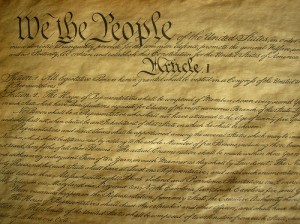Constitution
Liberty Amendments: a decision analysis

This week, Mark Levin, of the Landmark Legal Foundation, published his latest book, The Liberty Amendments: Restoring the American Republic. In so doing, Levin revives an often bitter debate among Constitutional conservatives. One side does not trust Congress to propose certain amendments they deem necessary to our liberty. The other side fears a repeat of the original Constitutional Convention. Which, they say, was a runaway convention that began with orders to amend further the Articles of Confederation and then destroyed that document. (Patrick Henry famously “smelt a rat” and did not attend that Convention.)
Leaders manage businesses or departments, treat medical patients, or otherwise must decide things. They often use a technique they call decision analysis. They seek to answer in advance these questions:
- What can I do to solve this problem?
- What’s the best that can happen? The worst? The in-between? (And what’s happening now?)
- What are the chances of each thing happening if I choose A? B? Or do nothing?
- How good (or bad) is each of these things that can happen or is happening?
The best decision is not that which avoids the worst risk. It is that which best balances risk and benefit.
This will be a decision analysis on Mark Levin’s Liberty Amendments, and how he wants to have the people propose and ratify them.
Liberty Amendments: what are they?
Before one can analyze a decision one must understand what he is deciding. Mark Levin wants to change the Constitution. Thomas Lifson at American Thinker reviewed Mark Levin’s Liberty Amendments here. The specific Liberty Amendments of the title are:
- Limit the terms of office for Senators and Representatives in Congress.
- Restore the Senate as a body of representatives of State legislatures, not merely “at-large representatives” of all the people in each State. In short, repeal Amendment XVII.
- Limit the terms of service for Justices of the Supreme Court.
- Provide that a super-majority of both Houses of Congress may override any decision of that Court.
- Limit the total federal budget to 17.5 percent of the Gross Domestic Product.
- Limit total federal tax collections from any one person to 15 percent of such person’s income.
- Shut down any federal agency that Congress does not reauthorize, and force Congress to ratify any regulation that will cost the economy more than $100 million.
- Refine and limit the Commerce Clause, so that Congress may not regulate commerce within a State.
- Restrict further the taking of private property for public use.
- Let two-thirds of the States amend the Constitution directly if their legislatures propose the same amendment, in the same words, within six years from first to last.
- Let three-fifths of the States overturn any Act of Congress, or any Executive Order having more than a certain impact, within twenty-four months, with such veto not subject to judicial review.
- Force all citizens voting in (one presumes) federal primary and general elections to identify themselves when voting in person or by mail. Forbid them to vote electronically in such elections.
One might quibble with one or more of these Liberty Amendments. Why, for instance, allow quasi-legislative and quasi-judicial bodies to make any rule that carries the force of law? By what authority does any President do anything by Executive Order, when that affects the “faithful execution” of law? Why not forbid Congress to set up any quasi-legislative and quasi-judicial body, and simply force Congress to make its own regulations, subject to judicial review or the three-fifths State legislative veto? And while we’re at it, why not repeal Amendment XVI and once again limit all direct taxes to that proportion of the population that resides in any given State?
But what those Liberty Amendments are, is one thing to decide. The other thing:
Liberty Amendments: how to enact them?
Lifson and John Hayward at Human Events describe how Mark Levin wants to enact his Liberty Amendments. (So does Levin himself; he posted his first chapter online.)
Obviously Congress would not incline itself to propose any limits on its power, or on the re-eligibility of its Members. So Mark Levin wants to force Congress to call a convention to get these amendments before the States.
Article V of the Constitution reads in relevant part:
The Congress,…on the application of the legislatures of two-thirds of the several States, shall call a convention for proposing amendments[. Such Amendments, in any ]case, shall be valid, to all intents and purposes, as part of this Constitution, when ratified by the legislatures of three-fourths of the several States, or by conventions in three fourths thereof[. And] one or the other mode of ratification may be proposed by the Congress[.]
Alexander Hamilton, in Federalist Essay 85, expanded on this point:
But every amendment to the Constitution, if once established, would be a single proposition, and might be brought forward singly. There would then be no necessity for management or compromise, in relation to any other point — no giving nor taking. The will of the requisite number would at once bring the matter to a decisive issue.
So each amendment would be a single issue. That includes each of the Liberty Amendments. Hamilton further points out that Congress cannot avoid calling a convention. The language is clear: shall call. And even after that, three-fourths of the States must ratify any Amendments such a convention proposes.
The Decision Analysis
And now, the decision analysis. First:’
Decision analysis: options
- Persuade a Member of Congress to introduce Congressional Joint Resolutions to propose these Liberty Amendments.
- Agitate for two-thirds of the State legislatures to apply to Congress to call an Article V convention to propose the Liberty Amendments.
- Do nothing.
“Do nothing” is always part of any decision analysis. A good leader always asks himself whether his strategy, if it succeeds, will improve matters, or make them worse.
Now:
Decision analysis: outcomes
Status quo. That is the “default outcome,” or what one would label “failure.” If we do nothing, we will have no Liberty Amendments.
Almost three years ago, Adam Freedman at National Review online said in effect: Failure is not an option. (Apologies to Gene Krantz, Flight Director, “White Team,” Apollo XIII.) He quotes a respondent of his, one Randy Barnett:
What’s worse, a convention that can be checked in numerous ways — not just one way, but many ways — or the runaway Congress we now have?
That’s the point. We have a runaway Congress. And today we have a runaway (de facto) President. Only yesterday he proposed to lay and collect a five-dollar-a-month tax on every cellphone or smartphone to fund wireless hotspots in every government school classroom in the country. A President is not supposed to have the power to lay or collect taxes. But since when has Barack Hussein (Herod?) Obama cared about what power the Constitution says he has or doesn’t have?
Runaway Convention. Larry Greenley at the John Birch Society smells Patrick Henry’s rat. He cites Edmund Randolph, President of the ratifying convention in Virginia of 1789. Randolph seemed to say the people could assemble in convention and do whatever it wanted. So Greenley assumes that applied to an Article V convention also.
But does it? Or was Randolph even talking about an Article V convention? No. He was talking about something much more fundamental, radical, and even revolutionary. One that goes beyond the Constitution itself. That kind of thing might still be necessary. But an Article V convention would make that less likely, not more.
Success. About which, enough said.
Decision analysis: results
Do nothing is not an option. So now we consider Option 1: get Congress to propose these Liberty Amendments. But would they? Ah, but they proposed term limits, didn’t they? Sure – perhaps knowing the Supreme Court would strike them down as somehow inimical to the people’s right to elect whom they please. Even if it’s the same-old, same-old. (Including even a corrupt federal judge after Congress threw him off the bench on impeachment for, and conviction of, bribery; witness Representative Alcee Hastings, D-Fla.)
And how likely is Congress to let the State legislatures go directly to amending the Constitution? Or to give the States a super-majority veto over their acts? Or especially to limit tax collections?
Option 2, getting legislatures to apply for an Article V convention, is now the most attractive.
- It has the only non-zero chance of success.
- It carries a slim, and arguably no, risk of a runaway convention. And the runaway convention might now be no worse than the status quo.
Few “no-brainers” turn up in decision analysis. A no-brainer is a decision that will not change with any reasonable value for the chances of success or failure, or the goodness or evil-ness of the outcomes. This decision might indeed be a no-brainer.
Editor’s note
CNAV remembers one of its contributors calling Mark Levin out after Levin seemed to dismiss any possibility that Barack H. Obama simply should not be in office. Mark Levin made a judgment, and presumably stands by it today, that Senator Marco Rubio, R-Fla., is a natural born citizen of the United States, by virtue of his birth on American soil. He relied on Amendment XIV and on the opinion in US v. Wong Kim Ark. Other Constitutional scholars and activists dispute him on this point. They cite an earlier opinion in Minor v. Happersett and the relevant definition in Vattel E., The Law of Nations.
That’s a dispute for another day. Perhaps the best way to resolve it might be to add to the Liberty Amendments, an amendment to make clear that a natural born citizen, again per Minor and Vattel, is one born in-country to two citizen parents, not merely one. (And who has standing to investigate or complain when an ineligible candidate stands before the Electoral College.) The question before the house today is: how to get Liberty Amendments, or anything like them, before State legislatures, and get them into force and effect.
[subscribe2]
Terry A. Hurlbut has been a student of politics, philosophy, and science for more than 35 years. He is a graduate of Yale College and has served as a physician-level laboratory administrator in a 250-bed community hospital. He also is a serious student of the Bible, is conversant in its two primary original languages, and has followed the creation-science movement closely since 1993.
-

 Civilization2 days ago
Civilization2 days agoDC Pipe Bomb Arrest Raises Questions About Christopher’s Wray’s FBI
-

 Civilization5 days ago
Civilization5 days agoYoo Hoo, VP Vance—Your Character is Showing!
-

 Executive5 days ago
Executive5 days agoThe Last Supper: New York’s Socialist Feast
-

 Guest Columns4 days ago
Guest Columns4 days agoCongressional Leaders See Far Higher Stock Returns Than Peers
-

 Civilization3 days ago
Civilization3 days agoThe Legal Logic Behind U.S. Operations Against Narco-Terrorist Networks
-

 Civilization5 days ago
Civilization5 days agoFacing Facts & Rolling Back Mythologies: The New National Security Strategy
-

 Civilization4 days ago
Civilization4 days agoHow Trump Changed America
-

 Executive3 days ago
Executive3 days agoNewsom’s ‘National Model’ for Homeless Wracked by Fraud




[…] to movement Conservatives. He lent credibility to the “alternate” amendment process. While this issue is not new, it has been a point of contention among Constitutionalists who realize that our […]
Michael Alan Kline Sr liked this on Facebook.